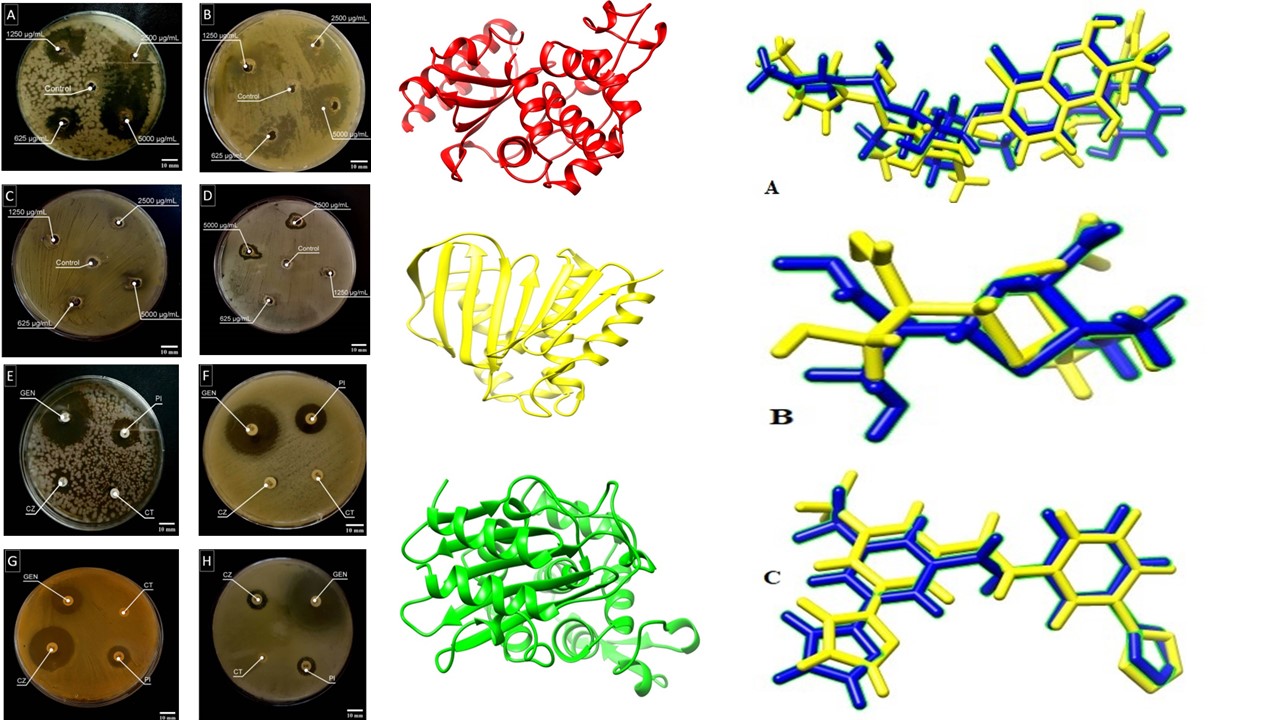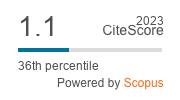An integrated investigation into the antibacterial and antioxidant properties of propolis against Escherichia coli cect 515: A dual in vitro and in silico analysis
DOI:
https://doi.org/10.55779/nsb16211837Keywords:
antibacterial activity, antioxidant activity, Escherichia coli, in silico, in vitro natural products, propolisAbstract
Urinary tract infections resulting from Escherichia coli, are prevalent and have become increasingly difficult to treat due to antibiotic resistance. This study aimed to explore the potential of propolis extract from beehives in Algeria’s Tiout region as a natural antibacterial agent against E. coli CECT_515. The phytochemical composition, antioxidant activity, and antibacterial action of the extract has been evaluated and compared to four synthetic antibiotics, both in vitro and in silico. The propolis extract had high levels of total polyphenol and total flavonoids, regarding its antioxidant properties, the extract showed an important ability of DPPH radicals scavenging, as determined by its IC50 value of 330.08±13.35 μg/mL. The excerpt showed important antibacterial efficacy against Escherichia coli, as demonstrated with important inhibition zones. The extract’s inhibitory effects were compared to four synthetic antibiotics, including gentamicin, pipemidic acid, cefazolin, and colistin, molecular docking analysis revealed that the propolis extract interacted with the active site of beta-lactamase, a protein responsible for antibiotic resistance, and showed binding affinities and conformational stability during molecular dynamics simulation for 250 ns. Overall, the results suggest that the propolis has significant antioxidant and antibacterial properties and could serve as a promising natural alternative to synthetic antibiotics for the treatment of E. coli infections.
Metrics
References
Abraham MJ, Murtola T, Schulz R, Páll S, Smith JC, Hess B, Lindahl E (2015). GROMACS: High performance molecular simulations through multi-level parallelism from laptops to supercomputers. SoftwareX 1:19-25. https://doi.org/10.1016/j.softx.2015.06.001
Al-Ani I, Zimmermann S, Reichling J, Wink M (2018). Antimicrobial activities of European propolis collected from various geographic origins alone and in combination with antibiotics. Medicines 5(1):2. https://doi.org/10.3390/medicines5010002
Almuhayawi MS (2020). Propolis as a novel antibacterial agent. Saudi Journal of Biological Sciences 27(11):3079-3086. https://doi.org/10.1016/j.sjbs.2020.09.016
Aukštuolis A, Girtan M, Mousdis GA, Mallet R, Socol M, Rasheed M, Stanculescu A (2017). Measurement of charge carrier mobility in perovskite nanowire films by photo-CELIV method. Proceedings of the Romanian Academy Series a-Mathematics Physics Technical Sciences Information Science 18(1):34-41. https://hal.archives-ouvertes.fr/hal-02443179
Banerjee A, Pal S, Goswami P, Batabyal K, Joardar SN, Dey S, ... Samanta I (2022). Docking analysis of circulating CTX-M variants in multi-drug resistant, beta-lactamase and biofilm-producing E. coli isolated from pet animals and backyard livestock. Microbial Pathogenesis 170:105700. https://doi.org/10.1016/j.micpath.2022.105700
Becke AD (1992). Density‐functional thermochemistry. I. The effect of the exchange‐only gradient correction. The Journal of Chemical Physics 96(3):2155-2160. https://doi.org/10.1063/1.462066
Becke AD (1996). Density‐functional thermochemistry. IV. A new dynamical correlation functional and implications for exact‐exchange mixing. The Journal of Chemical Physics 104(3):1040-1046. https://doi.org/10.1063/1.470829
Bitencourt-Ferreira G, de Azevedo WF (2019). Molegro Virtual Docker for Docking. In: de Azevedo Jr WF (Ed). Docking Screens for Drug Discovery. New York, NY: Springer New York, pp 149-67.
Bogart LM, Berry SH, Clemens JQ (2007). Symptoms of interstitial cystitis, painful bladder syndrome and similar diseases in women: a systematic review. The Journal of Urology 177(2):450-456. https://doi.org/10.1016/j.juro.2006.09.032
Bouras D, Fellah M, Mecif A, Barillé R, Obrosov A, Rasheed M (2023). High photocatalytic capacity of porous ceramic-based powder doped with MgO. Journal of the Korean Ceramic Society 60(1):155-168. https://doi.org/10.1007/s43207-022-00254-5
Bouras D, Rasheed M, Barille R, Aldaraji MN (2022). Efficiency of adding DD3+ (Li/Mg) composite to plants and their fibers during the process of filtering solutions of toxic organic dyes. Optical Materials 131:112725. https://doi.org/10.1016/j.optmat.2022.112725
Bruschi ML, Rosseto HC, de Francisco LMB, de Toledo LdAS, de A. Pereira RR (2017). Chapter 20 - Nanostructured propolis as therapeutic systems with antimicrobial activity. In: Grumezescu AM (Ed). Nano- and Microscale Drug Delivery Systems. Elsevier, pp 377-391.
Bussi G, Donadio D, Parrinello M (2007). Canonical sampling through velocity rescaling. Journal of Chemical Physics 126(1):014101. https://doi.org/10.1063/1.2408420

Downloads
Published
How to Cite
Issue
Section
License
Copyright (c) 2024 Farouk BOUDOU, Abdelmadjid GUENDOUZI, Amal BELKREDAR, Mohammed RASHEED

This work is licensed under a Creative Commons Attribution 4.0 International License.
Papers published in Notulae Scientia Biologicae are Open-Access, distributed under the terms and conditions of the Creative Commons Attribution License.
© Articles by the authors; licensee SMTCT, Cluj-Napoca, Romania. The journal allows the author(s) to hold the copyright/to retain publishing rights without restriction.
License:
Open Access Journal - the journal offers free, immediate, and unrestricted access to peer-reviewed research and scholarly work, due SMTCT supports to increase the visibility, accessibility and reputation of the researchers, regardless of geography and their budgets. Users are allowed to read, download, copy, distribute, print, search, or link to the full texts of the articles, or use them for any other lawful purpose, without asking prior permission from the publisher or the author.













.png)















